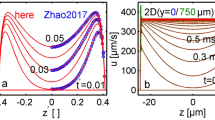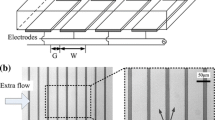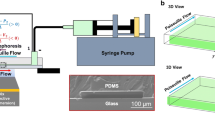Abstract
Field amplified sample stacking (FASS) is used to increase sample concentrations in electrokinetic flows. The technique uses conductivity gradients to establish a non-uniform electric field that accumulates ions within a conductivity gradient, and can be readily integrated with capillary electrophoresis. Conductivity gradients also cause gradients in near-wall electroosmotic flow velocities. These velocity gradients generate internal pressure gradients that drive secondary, dispersive flows. This dispersion leads to a significant reduction in the efficiency of sample stacking. This paper presents an experimental investigation of internally generated pressure gradients in FASS using micron-resolution particle image velocimetry (μPIV). We measure velocity fields of particles seeded into an electrokinetic FASS flow field in a glass microchannel with a single buffer–buffer interface. μPIV allows for the direct quantification of local, instantaneous pressure gradients by analyzing the curvature of velocity profiles. Measurements show internally generated pressure-driven velocities on the order of 1mm/s for a typical applied electric field of 100 V/cm and a conductivity ratio of 10. A one-dimensional (1D) analytical model for the temporal development of the internal pressure gradient generation is proposed which is useful in estimating general trends in flow dynamics.





Similar content being viewed by others
Notes
An ideal flow tracer would have zero electrophoretic mobility, but stability of the seed particle colloidal dispersion depends largely on surface charge. Aqueous solutions of uncharged particles, if realizable, are expected to suffer from particle flocculation, adsorption to the walls, and perhaps precipitation.
Abbreviations
- E :
-
applied electric field
- U :
-
liquid velocity
- L :
-
length of the channel
- α:
-
length of the high conductivity segment (xD) non-dimensionalized by L
- σ:
-
electrolyte conductivity
- ν :
-
electroosmotic wall mobility
- γ:
-
ratio of electrolyte conductivities
- eof:
-
electroosmotic flow
- p:
-
pressure-driven flow
- eph:
-
electrophoretic
- BGE:
-
back ground electrolyte
- s:
-
sample zone
References
Anderson JL, Idol WK (1985) Electroosmosis through pores with nonuniformly charged walls. Chem Eng Commun 38:93–106
Bharadwaj R, Santiago JG (2005) Dynamics of field-amplified sample stacking. J Fluid Mech 543:57–92
Burgi DS, Chien RL (1991) Optimization in sample stacking for high-performance capillary electrophoresis. Anal Chem 63(18):2042–2047
Chen CH et al (2005) Convective and absolute electrokinetic instability with conductivity gradients. J Fluid Mech 524:263–303
Chien RL, Burgi DS (1991) Field amplified sample injection in high-performance capillary electrophoresis. J Chromatogr 559(1–2):141–152
Chien R, Burgi D (1992) Sample stacking of an extremely large injection volume in high-performance capillary electrophoresis. Anal Chem 64(9):1046–1050
Coleman HW, Steele GW (1989) Experimentation and uncertainty analysis for engineers, 1st edn. Wiley, New York
Devasenathipathy S, Santiago J, Takehara K (2002) Particle tracking techniques for electrokinetic microchannel flows. Anal Chem 74(15):3704–3713
Huang XH, Gordon MJ, Zare RN (1988) Current-monitoring method for measuring the electroosmotic flow-rate in capillary zone electrophoresis. Anal Chem 60(17):1837–1838
Hunter RJ (1981) Zeta potential in colloid science. Academic, London
Jacobson SC, Ramsey JM (1995) Microchip electrophoresis with sample stacking. Electrophoresis 16(4):481–486
Jacobson SC, Hergenroder R, Koutny LB, Ramsey JM (1994) High-speed separations on a microchip. Anal Chem 66(7):1114–1118
Kasicka V et al (1997) Capillary zone electrophoresis with external radial electric field control of electroosmotic flow and its application to the separation of synthetic oligopeptides. J Chromatogr A 772(1–2):221–230
Kim MJ, Beskok A, Kihm KD (2002) Electro-osmosis-driven micro-channel flows: a comparative study of microscopic particle image velocimetry measurements and numerical simulations. Exp Fluids 33(1):170–180
Lin H et al (2004) Instability of electrokinetic microchannel flows with conductivity gradients. Phys Fluids 16(6):1922–1935
Manz A, Harrison DJ, Verpoorte EMJ, Fettinger JC, Paulus A, Ludi H, Widmer HM (1992) Planar chips technology for minituarization and integration of separation techniques into monitoring systems: capillary electrophoresis on a chip. J Chromatogr 593:253–258
Meinhart CD, Wereley ST, Gray MHB (2000) Volume illumination for two-dimensional particle image velocimetry. Measure Sci Technol 11(6):809–814
Olsen MG, Adrian RJ (2000) Out-of-focus effects on particle image visibility and correlation in microscopic particle image velocimetry. Exp Fluids 29:S166–S174
Quirino J, Terabe S (1999) Sample stacking of fast-moving anions in capillary zone electrophoresis with pH-suppressed electroosmotic flow. J Chromatogr A 850(1–2):339–344
Raviv U, Laurat P, Klein J (2002) Time dependence of forces between mica surfaces in water and its relation to the release of surface ions. J Chem Phys 116(12):5167–5172
Ren CL, Li DQ (2006) Electrokinetic sample transport in a microchannel with spatial electrical conductivity gradients. J Colloid Interface Sci 294(2):482–491
Ross D, Gaitan M, Locascio LE (2001) Temperature measurement in microfluidic systems using a temperature-dependent fluorescent dye. Anal Chem 73(17):4117–4123
Sadr R et al (2004) An experimental study of electro-osmotic flow in rectangular microchannels. J Fluid Mech 506:357–367
Santiago JG (2001) Electroosmotic flows in microchannels with finite inertial and pressure forces. Anal Chem 73(10):2353–2365
Szymczyk A et al (1999) An application of the space charge model to the electrolyte conductivity inside a charged microporous membrane. J Memb Sci 161(1–2):275–285
Thormann W et al (1998) Modeling of the impact of ionic strength on the electroosmotic flow in capillary electrophoresis with uniform and discontinuous buffer systems. Anal Chem 70(3):549–562
Wainright A et al (2002) Sample pre-concentration by isotachophoresis in microfluidic devices. J Chromatogr A 979(1–2):69–80
White FM (1991) Viscous fluid flow, 2nd ed. McGraw-Hill Series. In: Holman JP, Lloyd JR (eds) Mechanical engineering. McGraw-Hill, New York, pp 614
Yang H, Chien RL (2001) Sample stacking in laboratory-on-a-chip devices. J Chromatogr A 924(1–2):155–163
Author information
Authors and Affiliations
Corresponding author
Rights and permissions
About this article
Cite this article
Devasenathipathy, S., Bharadwaj, R. & Santiago, J.G. Investigation of internal pressure gradients generated in electrokinetic flows with axial conductivity gradients. Exp Fluids 43, 959–967 (2007). https://doi.org/10.1007/s00348-007-0366-3
Received:
Revised:
Accepted:
Published:
Issue Date:
DOI: https://doi.org/10.1007/s00348-007-0366-3




